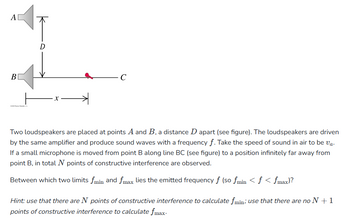Question
thumb_up100%
Dear,
Can you please give me the solution to this question and provide it with side drawings and explanations to understand the solution better?
Thank you in advance!!

Transcribed Image Text:A
B
D
X
C
Two loudspeakers are placed at points A and B, a distance D apart (see figure). The loudspeakers are driven
by the same amplifier and produce sound waves with a frequency f. Take the speed of sound in air to be va.
If a small microphone is moved from point B along line BC (see figure) to a position infinitely far away from
point B, in total N points of constructive interference are observed.
Between which two limits fmin and fmax lies the emitted frequency f (so fmin <ƒ < fmax)?
Hint: use that there are N points of constructive interference to calculate fmin; use that there are no N +1
points of constructive interference to calculate fmax.
Expert Solution
This question has been solved!
Explore an expertly crafted, step-by-step solution for a thorough understanding of key concepts.
This is a popular solution
Trending nowThis is a popular solution!
Step by stepSolved in 2 steps

Knowledge Booster
Similar questions
- Could you possibly include a picture of the written solution, the transcription gets a bit confusing! Thank you :)arrow_forwardA rectangular box with mass 16.5 g is said to have dimensions of 2.8 cm x 1.7 cm * 0.4 cm . Calculate the density of this rectangular box, in g/cm^ 3 . The volume of a rectangular box is length times width times depth (I^ * W^ * d) .arrow_forwardHow do I solve this?arrow_forward
- For (b), why do we divide the (100Wx8h) by (103Wh)? I get that we need to cancel out the Wh, but why do we divide by 103 specifically?arrow_forwardAn ant is crawling along a straight wire, which we shall call the z axis, from A to B to C to D (which overlaps A), as shown in the figure below. (Figure 1) O is the origin. Suppose you take measurements and find that AB is 44 cm, BC is 20 cm,and AO is 4 cmarrow_forward
arrow_back_ios
arrow_forward_ios